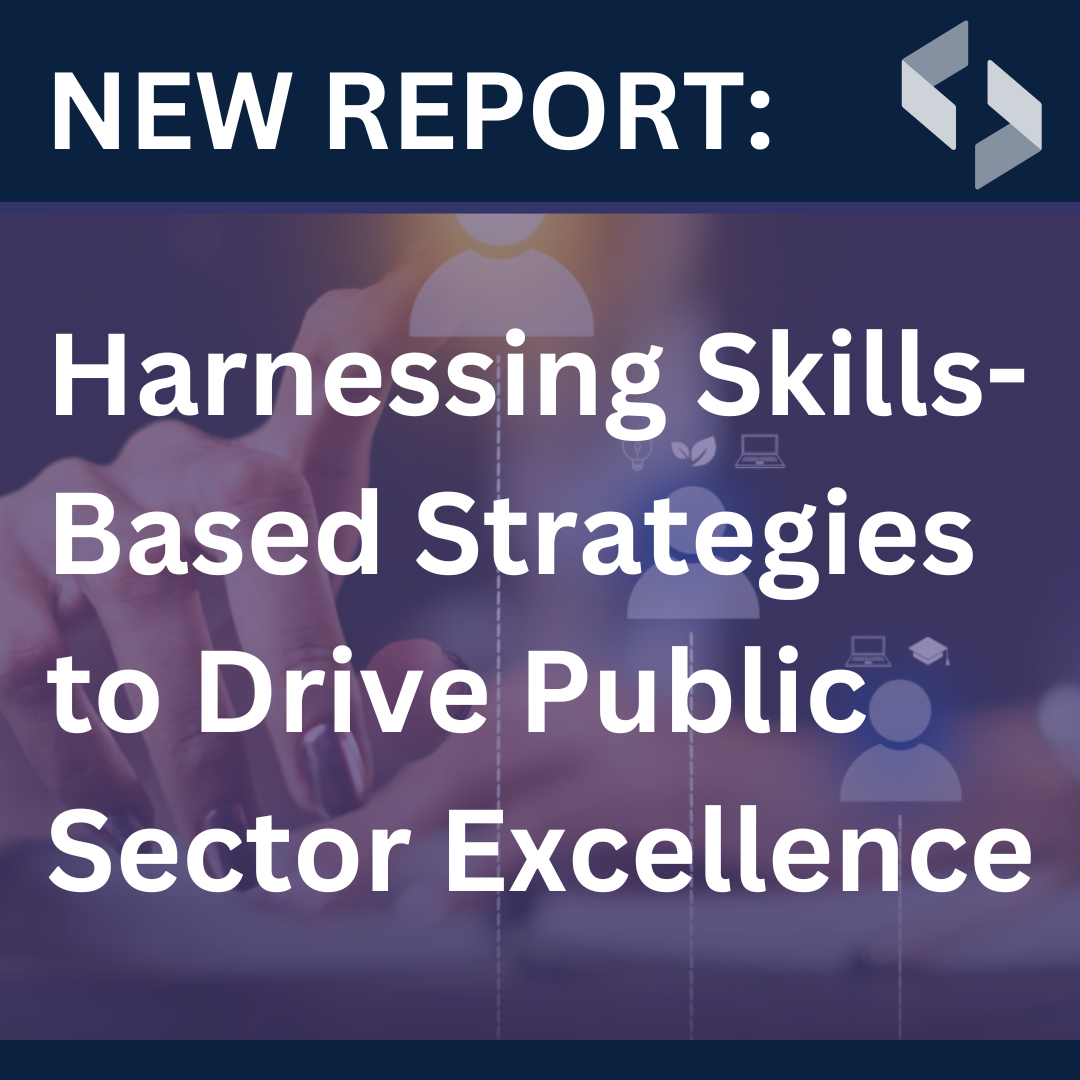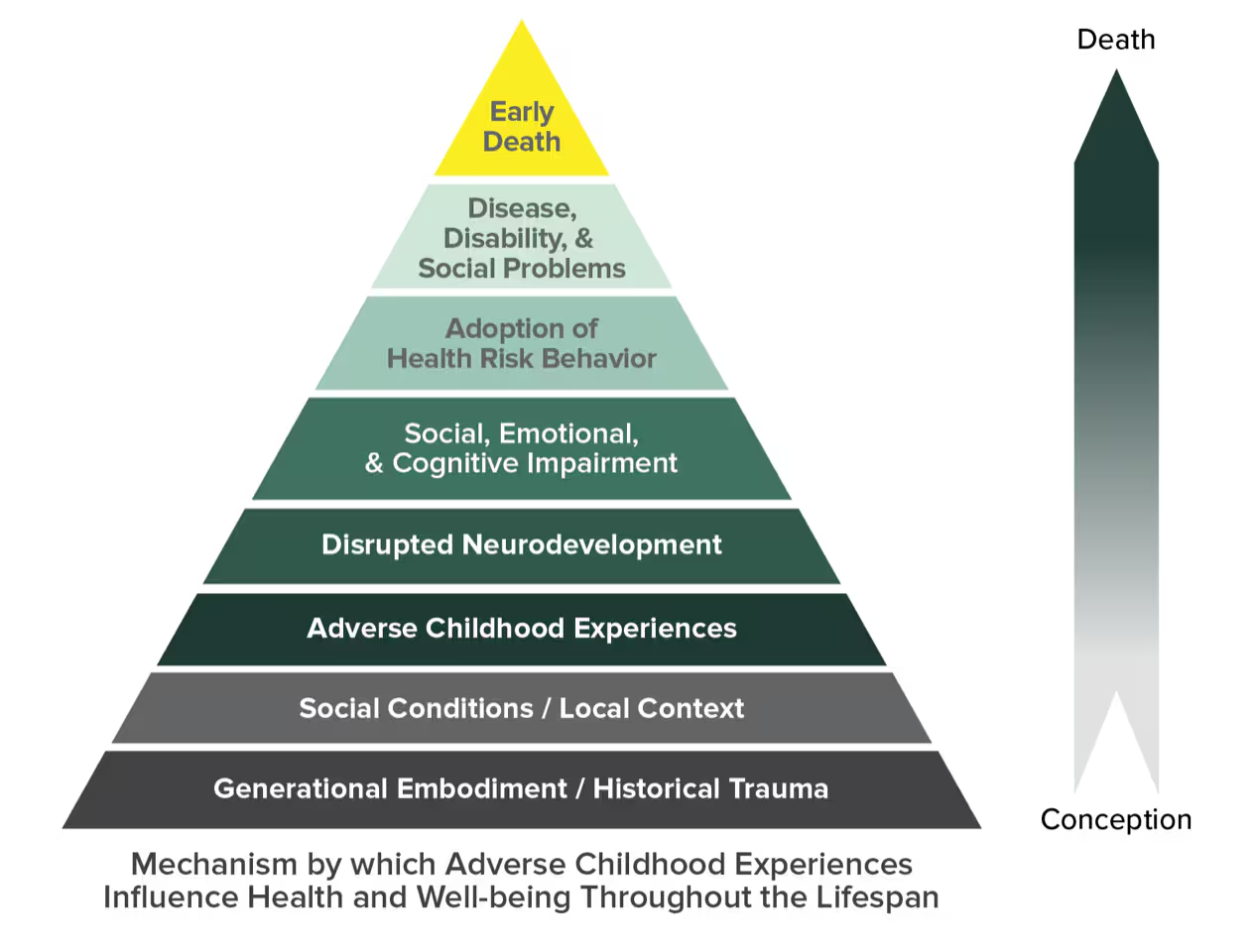This publication is focused on Governors’ strategies to address workforce challenges arising from the COVID-19 pandemic.
(Download)
This is the second in a series of five publications focused on COVID-19’s impact on maternal and child health (MCH) programs and populations in the U.S. Each publication focuses on a facet of MCH, including COVID-19 response and recovery, health and human services workforce, childcare, behavioral health, and community supports. The information contained in this series comes from a culmination of interviews and research conducted between early 2022 and January 2024, including an expert roundtable held in the Summer of 2022.
The COVID 19 Public Health Emergency (PHE) took a toll on already strained systems, more specifically, the health care and human service workforces. Across the country, many “frontline” workers transitioned out of the jobs they held prior to the pandemic — leading to employment rates below the projected trends from January 2020. Many of the negative impacts of the pandemic exacerbated existing health care workforce challenges, including increased personnel shortages, decreased employee mental health, and an increased imbalance where clinicians reported feeling the demands of their jobs were greater than the resources available to work effectively and efficiently.
The strain on the health care workforce was seen across communities, but more commonly among populations who encounter daily barriers to access health care perpetuated by social drivers of health (SDOH). Lack of racial and ethnic diversity in the health care workforce, limited access to specialists, and barriers to equitable insurance coverage were magnified throughout the pandemic, negatively impacting MCH programs and populations. The MCH provider shortages persist, and now, nearly 5 million women of childbearing age live in areas with limited or no access to maternity care. These compounding challenges have proven to not only hinder effective and readily accessible health care for women and infants, but they also impeded on the MCH workforce’s capacity to provide quality services.
In 2021, the Centers for Disease Control and Prevention (CDC) reported maternal mortality rates for non-Hispanic Black women of 69.9 deaths per 100,000 live births — almost three times as high as their non-Hispanic White counterparts reporting 26.6 deaths per 100,000 live births. Disproportionately higher deaths per live births compared to non-Hispanic White women, mirroring those of non-Hispanic Black women, are also seen in Hispanic and American Indian and Alaska Native (AIAN) women. MCH data paints a clear picture of birthing people with unique barriers, challenges, and needs often requiring specialized services.
A mother entering a high-risk pregnancy may need access to an obstetrician and, in extreme cases, a perinatologist—an obstetrician-gynecologist (OBGYN) physician who specializes in high-risk pregnancies—may be required. Not only is the number of obstetricians expected to decrease by seven percent in 2030, but 2018 data reported an inequitable decrease of obstetric services offered at hospitals in low-income, rural communities of color. Additionally, perinatologist, OBGYNs, midwives, and other MCH provider groups typically differ in race, ethnicity, and culture from their patients. With less than one-fifth of obstetricians originating from underrepresented racial and ethnic backgrounds, evidence correlates the lack of clinician diversity to patient satisfaction and access to quality care. Many MCH populations’ life experiences and overall health are impacted by disparities, inherently creating barriers to equitable health care.
The maternal and child health Workforce
The following is a snapshot of the different types of patient-facing professions within the MCH workforce.
- Case managers
- Community health workers
- Doula
- Family doctors
- General practitioners
- Genetic counselors
- Gynecologist
- Health educators
- Home visitors
- Lactation consultant
- Midwives
- Nurse practitioners
- Nurses
- Nutritionists
- Obstetricians
- Pediatricians
- Physicians’ assistants
- School nurses
- Social workers
- Therapists and counselors
Governors and state leaders can develop a strong MCH workforce by supporting patient-centered health policies while improving workforce environment and culture. Enhancing recruitment and retention can address high turnover rates and mitigate burnout. Partnering with education and hospital systems, non-profit groups and organizations supporting communities that are medically underserved can create pipelines into the MCH career field. Promoting diverse teams to increase cultural awareness, and implementing routine diversity and inclusion training can work toward establishing trust between providers and patients, while decreasing implicit bias and destigmatizing care.
Governors’ Strategies
This publication is focused on strategies Governors are using to address workforce challenges during and as a result of the pandemic. Some of these efforts include:
- Developing an equitable, strong MCH workforce through robust, diverse recruitment and cross-sectional, collaborative training.
- Exploring options to improve workforce culture by reducing burnout and appropriately accommodating pregnant and parenting workers.
- Collaborating across state lines to engender provider flexibilities.
Developing an Equitable, Strong MCH Workforce
Part of the Health Resources and Services Administration’s (HRSA) Maternal and Child Health Bureau’s (MCHB) strategic plan includes building and sustaining a workforce that is well-trained, diverse and prepared to address complex challenges. Governors and state officials can champion policies designed to rebuild workforce capacity while also confronting long-standing issues in recruitment, training and retention. Barriers exist from the start, as cost for higher education, training and certification programs can prohibit people from pursuing certain career paths. In many programs, students are discouraged from seeking employment whilst enrolled, putting undue strain on their ability to learn and earn an income simultaneously. Apprenticeships and similar programs can prepare the future workforce in industry-driven, high-quality opportunities where individuals obtain paid work experience, classroom instruction, mentorship, and a portable credential. In alignment with California Governor Gavin Newson’s goal to increase apprenticeships, the state has rolled out programs like the Earn and Learn Occupations Tool to allow individuals to grow and advance while earning a livable wage. Similarly, Iowa Governor Kim Reynolds announced the Health Careers Registered Apprenticeship Program to engage high school students by training them, paying them and offering opportunities to explore health care jobs while working. The program’s aim is to address current and future workforce shortages exacerbated by the pandemic.
People are leaving jobs for higher pay, better benefits or more flexibility after reevaluating their careers during the height of the pandemic. The MCH workforce has seen the same trends, including among some of the most critical provider types that are vital to increasing access, improving outcomes, and reducing disparities, but typically earn lower salaries. These providers, including doulas, home visitors and others in non-clinical settings, may provide services that are not reimbursable through health insurance or which receive very low reimbursement rates. Ensuring non-clinical providers receive a livable wage can improve recruitment and retention, giving more families access to these services. Ohio Governor Mike DeWine issued an Executive Order establishing the Governor’s Advisory Council on Home Visitation with plans to triple home visiting services across the state’s four models of care. The Council developed 20 recommendations for state agencies, including an effort to increase home visitors’ salaries, improve the structure to reimburse for services on time and offer incentive payments.
Adequate Medicaid reimbursement for doula services is particularly important to not only improve access to this care, but also vital to ensuring those providers earn a livable wage and continue in this field. Several states including Oregon, Minnesota, New Jersey, Florida, Maryland, and Virginia have pathways for doulas to enroll as Medicaid providers and receive Medicaid reimbursement for their services. Missouri Governor Mike Parson allocated additional 2023 state funding to implement the Cora Faith Walker Doula Training Program through developing, planning, and providing training for future doulas, doula trainers, and medical providers and support a free prenatal care clinic in Kansas City. In 2023, Nevada Governor Joe Lombardo signed legislation authorizing the Department of Health and Human Services to establish an incentive payment under the Medicaid program for doula services provided in rural areas and also requires the Department to seek an increase to certain reimbursement rates under the Medicaid program for doula services.
In addition to the strategies outlined above, Governors may also consider:
- Exploring options to provide or increase Medicaid reimbursement for doulas and other community health workers in the MCH space.
- Partnering with academic institutions and local hospitals to allow students in the health care workforce to receive education and gain experience simultaneously.
- Expanding enrollment for nursing programs at community colleges by increasing available slots for associate degree nursing programs.
- Developing processes and programs that engender diversity, equity and inclusion in recruitment, hiring and retention to ensure that all pregnant women receive culturally competent maternity care and support.
- Encouraging health care facilities and state provider associations to conduct outreach to a wider pool of candidates by collaborating with historically Black colleges, Latinx and Hispanic organizations, LGBTQIA+ organizations and additional non-profits or groups that support underserved communities.
- Partnering with hospitals and other health care facilities to create workforce development programs and scholarships for underserved communities.
STATE ACTIONS
The New Jersey Department of Health established the Colette Lamothe-Galette Community Health Worker (CHW) Institute through a Department of Labor Apprenticeship program. The goal of the Institute is to create a standardized CHW training and certification program to establish a robust workforce. The program will support CHWs throughout the state through its infrastructure while also creating a pipeline for CHW careers, enhancing CHW skills and sustaining an indispensable part of the larger health and human services workforce.
Exploring Options to Improve Workforce Culture
Heath care and human services providers faced the pandemic from both a personal and professional level, leading to unprecedented reports of post-traumatic stress disorder, anxiety, depression and burnout. Stress was reportedly highest among women and nurses, medical assistants, social workers and inpatient worker positions as well as Black and Latinx health care workers. Despite the increased reports, 35-54 percent of nurses and physicians and 45-60 percent of medical students voiced symptoms of burnout prior to the pandemic. Excessive workloads, administrative burdens, limited say in scheduling, and lack of organizational support were contributing factors toward burnout before 2020. Burnout, even amid a global pandemic, can be mitigated and addressed. Virginia, Indiana, South Dakota and Arizona all passed laws between 2020 and 2022 protecting health care workers seeking help with career fatigue and wellness. Requirements to report or file records of mental health challenges to their employees has hindered many providers from appropriately seeking help for their own mental health needs.
Black, AIAN and Hispanic women report experiencing discrimination and mistreatment when seeking care, especially related to family planning or pregnancy. Additionally, women with lower incomes report experiencing mistreatment from providers, with higher percentages among Black women compared to White women. Implicit bias training is often cited as a mechanism to address racial disparities like these, both within an organization’s structure and toward patients or clients seeking services. California, Maryland and Washington all passed legislation requiring implicit bias training for providers, and Michigan Governor Gretchen Whitmer issued a gubernatorial directive doing the same. Although implicit bias training can mitigate discrimination through increased awareness and targeted approaches, it is just one piece of a larger strategy to rectify structural inequalities. The Massachusetts Department of Public Health created a Racial Equity Data Road Map to expand the state’s efforts to eliminate racial discrimination within its systems. The Road Map is a living document, applicable to a variety of organizational structures. Complementing this work, the state also used Title V funding to hire a Racial Equity Coordinator to support staff knowledge of and capacity to promote racial equity; improve engagement and communication within and across bureaus; and encourage racial equity in public health practice across the state.
In addition to the strategies outlined above, Governors may also consider:
- Addressing health care workforce burnout resulting from the COVID-19 pandemic.
- Encouraging medical societies or associations operating in the states to establish access to confidential and voluntary support for health care workers seeking counseling or other supports such as professional coaching to help with stress or other issues in a physician’s personal or professional life.
- Working with the state legislature and licensing agencies to create legislative or regulatory changes that allow providers to receive care for career fatigue and wellness with confidentiality and civil immunity protections that would not impact their careers.
- Establishing a long-term commitment to address implicit biases and build cultural relevance within the health care system by investing in education, training and community engagement.
- Requiring health facilities and providers to obtain education on implicit bias and cultural competency to improve patient quality of care.
- Encouraging health systems and providers to hold listening sessions, town halls and focus groups within their communities to better understand how social discrimination, including racism, sexism and other intersectional biases, affect care.
- Enacting policies requiring employers to provide protections for pregnant workers such as economic security, reasonable accommodations and preventing job loss.
STATE ACTIONS
Nevada Governor Joe Lombardo signed legislation in 2023 ratifying recognition of the Emergency Medical Services (EMS) Personnel Licensure Interstate Compact. Nevada is the 23rd state to join the EMS Compact, which allows licensed EMS personnel from Nevada to practice across other member states without the need for separate licensing. More critically, it extends Nevada’s reach into a pool of over 400,000 EMS personnel, all sharing the same licensure standards across Compact states.
Collaborating Across State Lines
When COVID-19 cases peaked without available vaccines, providers were called to areas with high community spread, creating a need for Governors and state health officials to allow providers to work in states where they were not licensed. States passed emergency orders allowing providers to work not only in-person, but also through telehealth across state lines, so long as the provider was licensed in their home state and in good standing. Some states extended these temporary laws or statutes, including Kansas who allowed providers meeting certain requirements that are responding to COVID-19 to practice in the state through 2023. Many emergency orders, including those in Alaska, Arizona, Arkansas, Delaware, Hawai’i, Iowa, Kansas, Kentucky, Louisiana, Maryland, Mississippi, Montana, Ohio, Oklahoma and South Dakota, also allowed providers to see patients through telehealth without having to first be seen in person. Beyond the public health emergency, several states are codifying some of these measures to allow improved access to services via telehealth, especially related to behavioral health services.
- Evaluating opportunities for cross-border licensure and Medicaid reimbursement, including making permanent COVID-era executive orders and public health emergency provisions.
- Creating a process for provision of temporary licenses for out of state practitioners, pending licensing board approval for transition to full license.
- Considering joining or establishing licensure compacts for a variety of medical or Medicaid reimbursable services and providers.
- Extending or making permanent public health emergency orders to allow out-of-state providers to provide health services within the state.
- Exploring strategies that make COVID-era policies and reimbursements permanent to increase access to and improve continuity of needed health care and/or social services.
- Establishing policies that allow providers to utilize telemedicine platforms for pre- and postnatal care when appropriate.
- Providing greater access to technology to provide telehealth services including clinical, home visiting, mental health and social services to greater populations.
- Improving broadband access to rural and under resourced areas of the state.
- Allowing telephone or “telephonic visits” to qualify as a telehealth visit and be reimbursable as such.
- Waiving the need for a pre-existing patient-provider relationship to access a provider through telehealth or receive e-prescribing of medications.
- Encouraging widespread telehealth technology trainings to equip providers with the skills necessary to see patients via telehealth and ensure the workforce can meet patient needs appropriately.
- Evaluating cross-border licensing issues for telehealth Medicaid reimbursement by collaborating with state licensing boards and Medicaid agencies to determine a path forward.
Conclusion
The MCH workforce has seen signs of burnout and issues around racial discrimination for many years, but the pandemic brought these issues to the forefront, creating opportunities for Governors and state health officials to modernize. There are especially deep-rooted issues within the MCH workforce that affect Black and Native American women that must be addressed. Governors and state officials, however, must also reimagine the system to not only provide equitable services, but also to improve those services by modernizing systems that are overdue for an update.
Acknowledgments
The NGA Center would like to thank the state officials and experts who participated in the June 2022 expert roundtable as well as those who provided feedback to inform this publication. The NGA Center would also like to thank the Health Resources and Services Administration in the U.S. Department of Health and Human Services for their generous support of this project. The contents of this publication are solely the responsibility of the authors and do not necessarily represent the official views of HRSA or the U.S. Department of Health and Human Services.
This publication was developed by Michelle LeBlanc, Jessica Kircher, Asia Riviere, and Brittney Roy at the National Governors Association Center for Best Practices.
Recommended citation: LeBlanc, M., Kirchner, J., Riviere, A., & Roy, B. (2024). State Strategies to Address the Impact of COVID-19 on Maternal and Child Populations: Health and Human Services Workforce. Washington, D.C.: National Governors Association Center for Best Practices.













